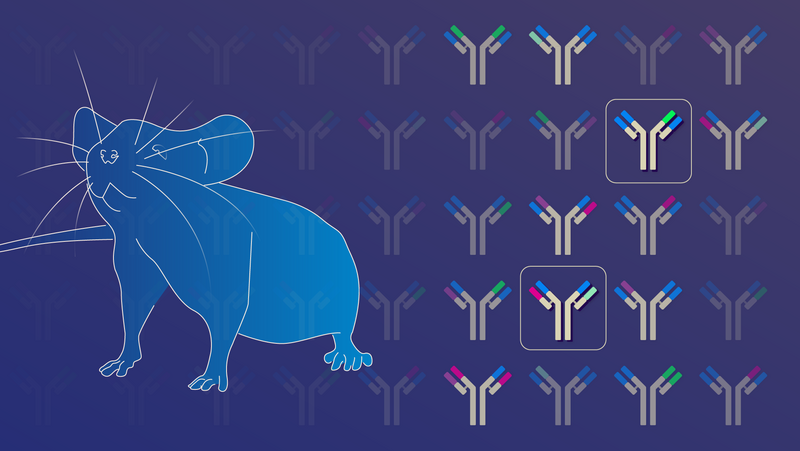Next generation transgenic mice for antibody discovery are here!
Blog Post | February 2, 2025
The Growing Potential of Antibody-Based Therapeutics
Antibodies have been part of the therapeutic toolbox for over 40 years and represent an exciting drug modality to treat various diseases, in particular cancer and autoimmune disorders1, providing a degree of specificity that cannot be achieved by traditional chemotherapy or radiotherapy. Monoclonal antibodies can be used as standalone therapy or in combination with other classes of drugs. Engineering antibodies into bispecifics or multispecifics to target different epitopes or antigens simultaneously, or engage immune cells, is a proven approach to enhance efficacy. The significant potential of therapies that not only use antibodies but also integrate antibody components (e.g., CAR-T for cancer immunotherapy applications) creates a need for more sophisticated discovery platforms that are easily accessible for drug developers to accelerate development of such life-saving therapeutics.
In Vitro and In Vivo Approaches to Therapeutic Antibody Discovery
Transgenic and wild type animals, as well as phage or yeast display technologies, are the most commonly used methods for antibody discovery. Phage and yeast display are in vitro platforms in which antibody gene sequences, isolated from human B cells or other antibody repertoires, are expressed on the surface of bacteriophages or yeast. Such display libraries typically contain only human variable region fragments, typically fragment antigen binding (Fab) or single-chain variable fragment (scFv), that bind to target antigens. These display libraries are powerful tools for discovery given their scale and flexible design, which allow screening of large libraries against any antigen under desired selection conditions. However, antibodies discovered by display techniques can exhibit unfavorable biophysical characteristics such as poor solubility, low thermal or chemical stability, high viscosity, or short half-life in circulation amongst others that may limit their therapeutic potential and are associated with higher developability issues relative to antibodies derived from transgenic animals.2 Typically, antibodies generated by transgenic animals are more likely to have favorable characteristics for their development, manufacture, and use as therapeutic agents.
Transgenic Mice and the Generation of Chimeric Antibodies In Vivo
Early in vivo antibody discovery approaches leveraged wild type mice with no genetic humanization, which are still used today. Murine antibodies, when administered into humans, show impaired efficacy in most cases due to immunogenicity and associated adverse reactions3, and the inability to engage human Fc (fragment crystallizable) receptors. Antibodies discovered from wild type mice require significant engineering downstream to remove immunogenic mouse regions and to be able to engage human Fc receptors. Thus, while wild type mice are easily accessible, they are not ideal for antibody discovery.
To better solve the immunogenicity problem, wild type mice producing fully human antibodies were created, but the absence of mouse constant regions resulted in impaired B cell and antibody development within the mouse. The next generation of transgenic mice were humanized only at the variable antigen-binding regions to enable proper B cell development, whilst reducing the amount of downstream engineering required to create viable candidates. These mice create antibodies with high affinity and specificity against a broad spectrum of human antigens. However, challenges remain, including limited access, high costs, and unclear intellectual property positions associated with these models.
To that end, JAX, an expert in providing transgenic models, has partnered with AbTherx, a company with deep knowledge in the antibody discovery space, to make high quality and novel transgenic models available to drug developers of all sizes for their in-house discovery programs.
Novel Transgenic Technologies for Therapeutic Antibody Discovery
The Atlas™ Mouse platform represents the next generation of transgenic animal models, developed using state-of-the-art targeted knock-in gene editing techniques to replace the respective mouse regions. Atlas™ Mice generate antibodies with human variable regions fused to the full constellation of murine Fc’s, which retain a full complement of human diversity, and that are selected for and matured in vivo, simplifying downstream engineering and streamlining the discovery and development process. The underlying philosophy behind the Atlas™ Mouse platform is to create and deliver models that express native or near-native antibody structures, which are vastly preferred from both developability and immunogenicity standpoints.
The Atlas™ Full Human Diversity Mouse for monoclonal antibody discovery is engineered to replace the mouse heavy and kappa light chains with human sequences within the variable domain, in contrast to other commonly used models that use random or non-native loci for integration. The inserted cassettes comprise >99% of commonly expressed human sequences and use only functional variable heavy and kappa light chain regions (as determined by the IMGT® immunoinformatics platform).
Further development has been conducted in the model in which two human fixed, or pre-rearranged, light chains can be expressed that contain overlapping and distinct abilities to pair with cognate variable heavy chains (Atlas™ Binary Fixed Light Chain Mouse). This allows for target-driven expression from one of two fixed light chains compared to only one fixed light chain as in most other models, thereby increasing overall repertoire diversity. Obtaining antibody leads with common or fixed light chains facilitates generation of bispecific modalities without negatively impacting antibody structure. Such models enable the development of a bispecific format with developability and PK properties most similar to a native antibody. Other bispecific formats that do not contain these more natural IgG formats have been shown to differ from native antibody properties in PK, immunogenicity, and developability. It’s an exciting time for therapeutic antibody drug development, and accessibility to high-quality transgenic models is key in the quest for novel therapeutics to advance human health.
Learn more about JAX's platforms for antibody discovery and development on our Antibody Therapeutic Services page.
- Puthenpurail A, Rathi H, Nauli SM, & Ally A. A brief synopsis of monoclonal antibody for the treatment of various groups of diseases; World J Pharm Pharm Sci (2021); 10(11):14-22
- Jain T et al. Biophysical properties of the clinical-stage antibody landscape; PNAS (2017); 114(5):944-949
- Hwang WY & Foote J. Immunogenicity of engineered antibodies. Methods (2005) 36(1): 3–10
